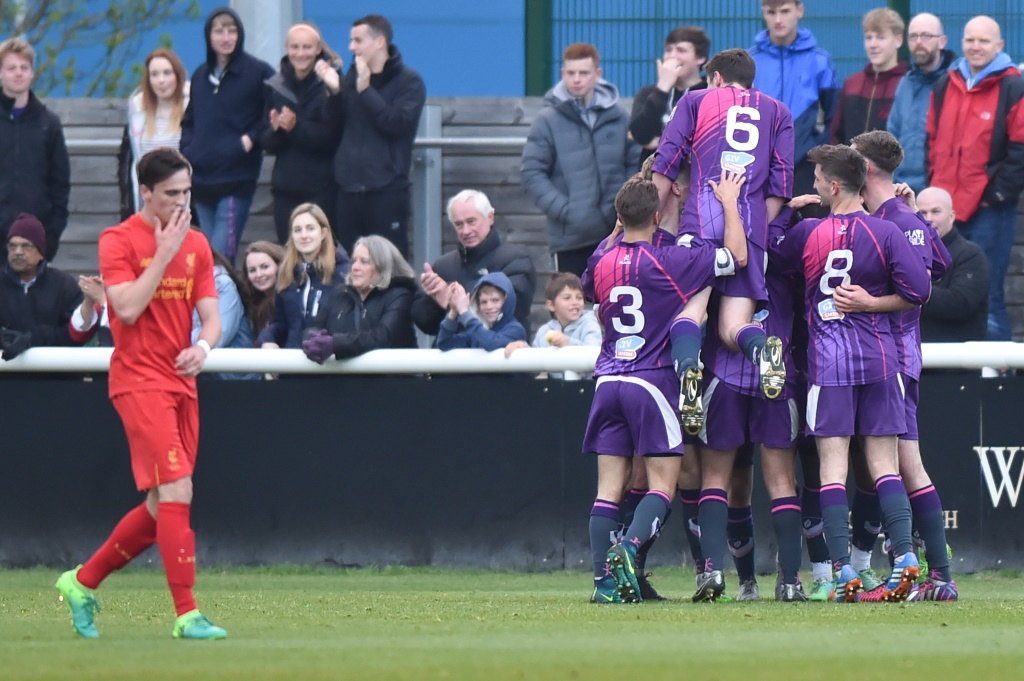By Chris Evans
WALKING up to Loughborough University Stadium, it’s clear that this is home to no ordinary Non-League club.
The £4million ground’s tall pine exterior arches out of the floor to provide a domineering welcome, while the pristine pitch and towering main stand complete a setting that is more akin to a Premier League club’s youth academy than a Midland Football League venue.
It’s home to Loughborough University FC, one of Britain’s growing number of university football clubs cropping up in Non-League across the country. And the potential that student teams are showing could lead to a revolution that might change the face of grassroots football forever.
At Loughborough, the university offers a unique football experience. While playing and training in facilities that would draw envious looks from many of the nation’s pro clubs has an obvious attraction, players also juggle studying with a full-time football programme coached by a raft of highly qualified coaches.
Youngsters who take the novel route of combining study off the pitch with learning on it are also rewarded with marquee matches against the likes of Liverpool, with last season’s encounter with the Reds coming just days after a defeat to Lye Town.
Although many of the clubs flying the university flag in senior leagues can’t boast the same standard of facilities as Loughborough, more student sides are waking up to the advantages of offering a full season of competitive football in Non-League.
One man who is benefiting from the influx of higher-education teams in the football pyramid is England Universities head coach Andy Coyles, who has witnessed a shift in the way university football is viewed in recent years.
“University clubs provide a fantastic opportunity for players because they’re getting the best of both worlds: playing football to a good level and also getting a degree as a form of security,” said Coyles.
“The standard of players we’re working with for England Universities is incredible and a good number of those students could go on to play in the National League or even higher in the Football League.
“There is a hell of a lot of scouts attending our games now and university footballers are starting to understand that it’s never too late to give up on their dreams – gone are the days when footballers weren’t going to make it if they hadn’t made it into a professional team by the age of 15.”
The student invasion isn’t just restricted to England though. Last season, Welsh Premier League outfit Cardiff Met FC earned national headlines when they came within a Europa League play-off defeat from becoming the first university club to ever qualify for European competition.
North of the border, Stirling University – managed by Scotland Ladies boss Shelley Kerr – finished third in the Highland Football League in 2015, only two positions away from entering a play-off of their own to get into the Scottish Football League.
Coyles says the potential for university football to grow in the senior ranks is there for all to see and points out that, as the university sides go on to establish themselves further, it’s only a matter of time before there’s even more success.
“Cardiff Met is a great example,” Coyles said. “Their story shows what a university side playing in senior leagues can achieve.
“Universities can offer an almost professional setup, where you combine academic classes with a professional lifestyle that provides top coaching, nutritional advice and sports analysis that you wouldn’t find elsewhere at that level.
“Universities have got a strong financial backing and with 50-odd thousand people attending, there’s an opportunity for the teams to grow in terms of support as well. We should look at what happens in the US, where up to 80,000 people go to watch their college sports teams play.”
While student teams are proving that they’re more than just novelties, England’s university clubs have a hurdle much bigger than simply a lack of experience to contend with.
In the wake of Team Bath reaching the Conference South in 2008, the FA placed a cap on all university teams to stop them progressing beyond the eighth tier due to their ownership structures. A ruling that seems unfair considering the flimsy Fit and Proper Person specs that have allowed a flurry of owners with questionable credentials to take the reins at Football League clubs in recent years.
Coyles’ university, Team Northumbria, are one of the sides likely to suffer as a result of the rule. Like Loughborough, Team North run an almost professional football set-up while competing in the Northern League, but are having to let some of their better players fly the nest before they’ve graduated.
“The league Northumbria is in is three or four levels below the standard that some players could play at,” added Coyles.
“That means we have players going out to play for South Shields or Gateshead in the National League instead. Those players get to play higher, but miss out on training and playing together on a daily basis in an environment that allows them to live the professional lifestyle of an athlete, while also gaining an academic degree.
“You shouldn’t put any stop signs in the way of uni sides progressing because their full potential could be great for the game. It isn’t right [for the FA] to say we’ll support university teams playing to a certain level, but if they overachieve, they can’t come up again.”
If the FA’s bigwigs were to relax the rules on university sides, the potential they’d have to succeed is huge.
By establishing themselves as a credible alternative to get into the game and offering a safety net for academy drop outs, the wave of university clubs in Non-League could grow as they play a bigger role in the developing the stars of tomorrow.
And the results they could achieve would be far more than ordinary.
Chris Evans is the author of ‘Learning Curve: Life inside one of Britain’s most unusual football clubs’ – available to buy on Amazon
























